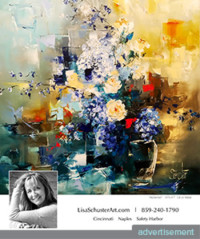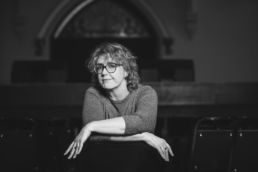words SHARMAINE MCLAREN | photography DEOGRACIAS LERMA
 Cedric Michael Cox is best known for his paintings and fanciful murals that color the Cincinnati urban landscape with expressions of his unique style, which lives somewhere between the worlds of surrealism and representational abstraction. Cedric’s work encapsulates innercity life, exuberant and interpretive, with subtle references to mythical creatures and musical theatrics that dance endlessly across a boundless imagination.
Cedric Michael Cox is best known for his paintings and fanciful murals that color the Cincinnati urban landscape with expressions of his unique style, which lives somewhere between the worlds of surrealism and representational abstraction. Cedric’s work encapsulates innercity life, exuberant and interpretive, with subtle references to mythical creatures and musical theatrics that dance endlessly across a boundless imagination.
In the studio where he lives and creates, Cedric’s work, both finished and in progress, hangs, stands, and drapes over nearly every inch of the space. Pieces vary in dimension from wall-sized canvases to intimate fiveinch squares, but all are bound together by the artist’s unique aesthetic. Entering the space, it is nearly impossible to keep from smiling as bright colors sweep the eye into a rhythm of painted sounds and visual lyrics.
A large piece, with shapes undefined, waits with anticipation for the forms it will cradle in its sea of blues and greens. On a large drafting table, initial renderings of a commissioned piece sit beside books used as inspiration, and hanging just to the left, inspirations come to life on his canvas. Opening studio and mind, Cedric shares his philosophy and his creative process.
Polly: You credit cubism as most influential in your work. What drew you to cubism?
Cedric: I was drawn to cubism initially because I had a lot to say about a particular object and subject at the same time. In cubist paintings, there is not a differentiation between foreground and background. It is all one in the same, and it is about juxtaposition. My style, from the very beginning when I first picked up a pencil as a kid, was not about describing the foreground and background, but about bringing everything to the same level of continuity. My work was very sculptural, concrete in gesture and form. I find that, whether I am working in realism or abstraction, my work references cubism.
In college, when I was being asked to declare my aesthetic style, I found myself drawn to the work of Lyonel Feininger, Juan Gris, Picasso, and Braque. Their work spoke to me. It had rhythm and form. It wasn’t about what they were saying or how they were saying it; it was how well they said it that mattered to me. I wanted to work in that genre.

P: You have also described your work as surrealist. Associated often with Dalí and Magritte, the style bears little resemblance to your work. How do you feel that surrealism is expressed in your work?
C: Surrealism, for me, is how I describe the merger of abstraction and realism. I studied the work of Bradley Walker Tomlin. An abstract expressionist, he would take letters and text from various cultures and configure paintings from them. I interpreted surrealism as taking things from reality and then reinterpreting and reconfiguring them in a different way. I believe cubism is a form of surrealism, because it is altering reality and our perception of reality. Normally when you think of surrealism, you think of something rendered to a certain point realistically then positioned in a skewed way.
When I do figurative paintings, I make an effort to elevate the image by taking aspects of reality a step further beyond representational abstraction to more recognizable imagery. To me, that is moreso surrealism than Dalí and those others most associated with the genre. One example of this is the Amberley Village mural. It is in appreciation of Gustav Klimt’s mythical creations.
P: In Figs Dancing in the Midnight Mist, the viewer can feel the dance before reading the title. In contrast, Sculpture Garden feels to me like a grounded, contemplative space to reflect. Can you share the creative technique you employed to produce such different emotional responses?

C: Sculpture Garden came from a desire to change up my subject matter and move toward organic forms. It was an earlier piece that came about as I loved from cityscapes to forms in nature. I was still holding onto the idea of structures. Structures come from the ground. They dig a hole in the ground, pour concrete, and build these monuments, similar to what we do in the garden. We are digging into the earth, planting, and a very linear thing happens as it grows. Sculpture Garden is the beginning of this shift; it is a smaller, more intimate piece, still and contemplative, with a limited palette. You can see the shift where I am moving from architectural forms to natural imagery. Figs Dancing in the Midnight Mist is the crown jewel of where my development is now. It is one of the last paintings I have completed that I feel very comfortable with. It reminds me of Paul Klee paintings, specifically The Goldfish and another titled Landscape with Yellow Birds. It has the atmospheric, but at the same time, it has an all-over compositional climax and points toward the direction I am moving.

P: Quite a bit has been written about your work, but little has been written about your life. When did you first know you wanted to paint? How old were you when someone first called your work “art”?
C: I was in first grade when my drawing teacher held up one of my drawings. We were drawing teddy bears. I believe the goal of the exercise was to teach everyone shapes and to try to get everyone to draw a circle for the belly, an oval for the eyes, etc. However, when I drew the bear, I drew a Robin Hood bear. I will never forget that moment when the teacher acknowledged my work, and people starting asking me how I did it. It was then that I realized that I did things slightly different than everyone else. After that, my mom bought some art paper, and my fascination with foreground and background, which continues in my work today, began. My dad actually framed one of those early paintings because he saw something artistic in it. I did not see it, but he did. That was the first time I felt like an artist.








